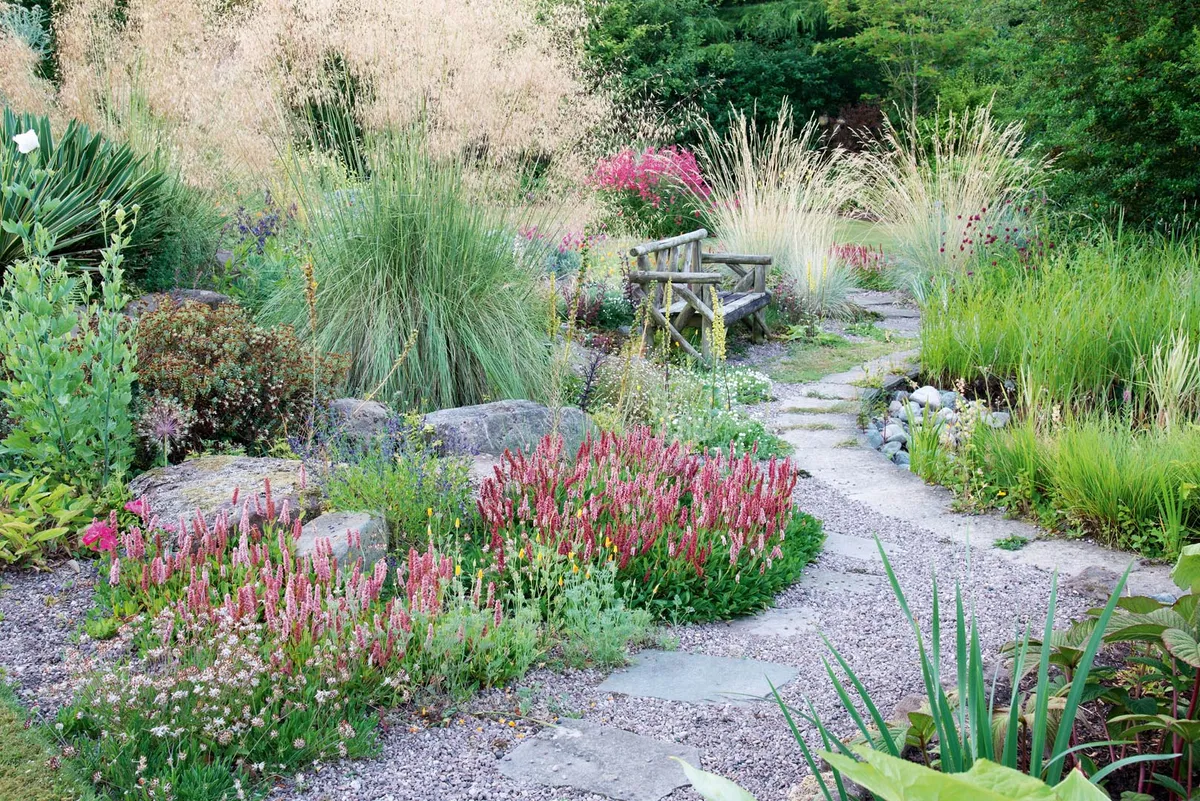IN BRIEF
Name Bluebell Cottage. What A densely planted garden, which showcases the wide range of plants that will thrive in the area. Where Cheshire. Size One-and-a-half-acre garden within a six-acre site. Soil Rich, sandy loam. Climate A benign mild and damp climate. Hardiness zone USDA 8.
The origins
Fifteen years ago, businesswoman and award-winning amateur gardener Sue Beesley fulfilled a long-standing ambition to buy a run-down nursery and garden. After a lot of hard work, and some mistakes along the way, she has, with the help of her team, transformed the place into a thriving business and created an elegant, plant-filled garden that is popular with gardeners from around Britain.
The site is in the lush Cheshire landscape bounded by the hills of North Wales to the west and the foothills of the Pennines to the northeast. The garden sits next to a curve in the Trent and Mersey Canal and its billowing borders echo the distant, rolling treescape and evoke the sweep of the water as it flows gently past.
Perennial planting
The main beds are densely planted with mainly herbaceous perennials that respond to even the slightest breeze. “Nothing stands still in this part of the garden,” says Sue. “Here I’ve chosen mainly plants that accentuate movement.” Angel’s fishing rod (Dierama pulcherrimum) sways gently while the tall stems of Helianthus salicifolius dance in the background and the area is filled with the ripple of grasses, from tall Miscanthus and Calamagrostis to the short tufts of Stipa tenuissima ‘Wind Whispers’, a cultivar that Sue recommends because of the way it does not become matted.
The planting is exuberant and close-packed. Looking across the area, what the eye sees are diaphanous curtains of plants but, in fact, wide, grass paths crisscross the garden, meaning you can lose yourself among the plants, taking time to linger on one of the many benches that Sue has placed in the garden.

“I point out to visitors that in a classic British garden borders are planted around a lawn – here plants are in the middle and grass paths run around and through the plantings. It doesn’t look like it but there are paths within three feet of every plant so we can get in to maintain them. I suppose that is my ethos – put layers of plants centre stage and put functional elements such as paths on the outside.” One of Sue’s favourite plants, the white umbellifer Cenolophium denudatum, is threaded through the border. “So many of the umbellifer family are annuals or short-lived but this one is perennial, not a problem seeder and so beautifully light and elegant,” she enthuses. “It is a plant that more people should know.”

Mixing colours
The colours are vibrant and punchy. A deep-purple Salvia nemorosa ‘Amethyst’ weaves around the flamboyant, red flowers of Monarda ‘Jacob Cline’ and the bright-magenta flowers of Lychnis coronaria are speckled through large parts of the border. The Lychnis behaves like an annual and, as with the orange-flowered Papaver atlanticum, Sue allows them to self-seed. “I don’t consciously place annuals but rather let them grow where they want to and edit them out if they are in the wrong place or when they tip over from being pleasurable to being too much.”

A path through an arch in a tall yew hedge leads from the brouhaha of this part of the garden to the quiet and calm of an enclosed gravel area where the heat seems to rise from the rocks and stones. Three huge clumps of Stipa gigantea dominate, on a carpet of persicarias and low-growing sedums, dotted around with Dianthus carthusianorum, tiny pulsatillas and mounds of Baptisia.

In contrast, beyond the dry garden is a section enclosed by tall trees. Shady and cool, it is the perfect place for epimediums, beesias and another of Sue’s favourites, tall thalictrums. “I don’t have the collecting gene but I have a lot of thalictrums – I do love them,” she says. “When you look at them, they are 99 per cent air and one per cent plant, all light and delicate.” And, throughout the garden, in all her plantings, that sensation of lightness and delicacy is exactly what Sue has achieved.
USEFUL INFORMATION
Address Bluebell Cottage, Lodge Lane, Dutton, nr Warrington, Cheshire WA4 4HP. Tel 01928 713718.
Open Garden and nursey open Wednesday to Saturday, 10am-5pm.
